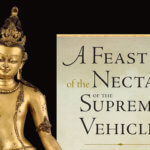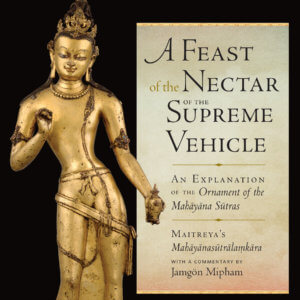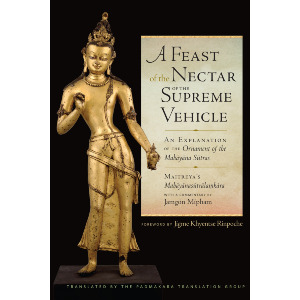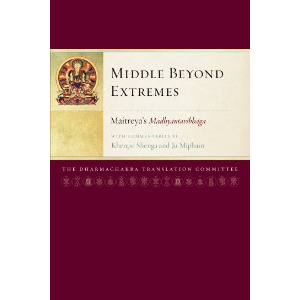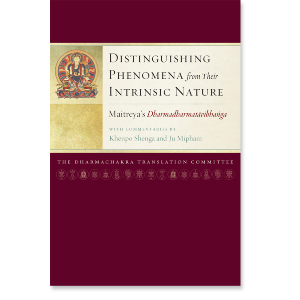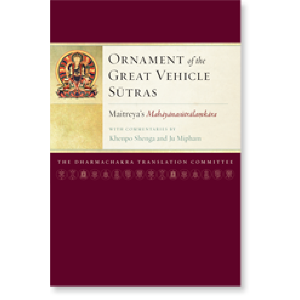1. Showing Why It Is Worth Teaching Others the Dharma Unstintingly
When bodhisattvas thoroughly investigating the Dharma have received the teachings and gained unmistaken realization of them, they explain them unstintingly to sentient beings and thereby complete their own transcendent perfections and bring other sentient beings to maturity. There is no better means for doing so than this, and one should therefore do whatever one can to teach.
If steadfast bodhisattvas joyously and forever give away immense gifts to beings who suffer—
The lives and riches they have won with such great difficulty and yet devoid of essence—
Need one mention their unstintingly giving of the vast Dharma that benefits beings in every way,
That is found with no great difficulty, and even when given away entirely grows inexhaustibly? (XIII, 1)
Steadfast bodhisattvas have realized that even though their bodies or lives, won with great difficulty by accumulating virtue in the past, and their wealth, acquired through great hardships such as journeying overseas, belong to them, these finally come to an end and are meaningless and unreliable. So it is with sheer delight in practicing generosity that they are forever giving away material gifts to suffering beings—vast riches or dominions that can completely fulfill others’ wishes. If they can do this, then need one mention their giving away—and not just once—the vast and sacred Dharma, which will never be exhausted? Of course bodhisattvas will teach others, once they have investigated the teachings, for the Dharma benefits beings in every kind of way in both this and other lives and therefore, unlike material gifts, is utterly reliable and worthwhile. At a time when the Buddha has appeared in the world and his doctrine endures, anyone seeking the teachings can receive them quite easily without going through the enormous difficulties—setting out to sea, and so on—involved in the acquisition of material riches. And the gift of Dharma, even if given away completely, not only never runs out in the bodhisattva’s mind stream but will grow more and more, spreading from one person to the next. (The Tibetan syllable lta in the last line has no significance other than completing the meter.)
2. The Reason for Teaching the Dharma
Because it is to be known by oneself, Lord Buddha did not teach the Dharma;
Yet with the breath of his teachings, rationally explained, the embodiment of compassion, like a python,
Draws beings onto the path, setting them perfectly in the mouth of total peace,
Utterly pure, vast, common, and inexhaustible. (XIII, 2)
Consequently, no practitioner’s meditation is pointless,
And thus neither are the teachings of the sugatas pointless.
If one could see the meaning simply by listening, there would be no point in meditating,
And if one could practice meditation without having listened, there would be no point in teaching. (XIII, 3)
Although the ultimate realization that the noble beings are to know by their own individual experience is beyond the realm of words and letters, it is impossible to ever attain it without listening to and reflecting on the Dharma of transmission that is indicated by words and letters. This is why Lord Buddha taught the Dharma of transmission, which can be heard and reflected upon, as the means for realizing that personally experienced wisdom. It is impossible to show the Dharma of realization, the individually experienced wisdom present in the minds of noble beings, directly to beings who have not realized it personally. So because that Dharma of realization can only be known by actual personal experience, the buddha bhagavāns have not taught such a Dharma in the form of words and letters. They cannot demonstrate how it is with words and letters, saying, “This is the point that has to be realized individually.” It is beyond the expressions, concepts, analogies, and reasoning of ordinary people, which is why we say that it can only be known personally. It is not like the mundane knowledge of compounded phenomena such as vases and uncompounded phenomena such as space: suchness is something that is realized personally by those who have the gnosis of the noble beings. If the object of experience of those who have attained mundane dhyāna cannot be imagined by beings who have not attained it, then it goes without saying that the object of experience of supramundane gnosis is not something that can be conceived of by an ordinary person listening and reflecting.
How is it, then, that the profound sūtras are said to explain the certain meaning—the Buddha’s realization, the point that can only be realized personally? This is explained by a metaphor comparing Lord Buddha, who is the embodiment of compassion for sentient beings, to a giant snake. There is a giant snake, a python, that leaves behind it a furrow the size of a river, filled with the saliva flowing from its mouth, so that from a distance it looks like a huge river. The deer, thinking that it is a river, go to drink from it, whereupon they are killed by the poisonous saliva and sucked into the python’s mouth as it breathes in. Thus it is that the Buddha (illustrated by the python) draws potential disciples (analogous to the herds of deer) onto the correct path to buddhahood by means of the Twelve Branches of Excellent Speech, which are capable of drawing in others (like the python’s breath)—the Excellent Words that he expounds perfectly logically and reasonably, that is, with no mistake in any points, for they possess the four kinds of rational application. Drawing them in, he finally places them in buddhahood (the snake’s mouth)—the body of truth, nirvāṇa, in which suffering and the origin of suffering are completely pacified; the transcendent state of sublime purity (in which the two obscurations have been purified), of sublime bliss (which is endowed with the vast qualities of the ten strengths and so forth), of the sublime “self” of a great being (for it is common to all the buddhas), and of the sublime eternity (for it will never know an end).
The Dharma benefits beings in every kind of way in both this and other lives and therefore, unlike material gifts, is utterly reliable and worthwhile.
This is the truth-body buddha, the culmination of personal realization, and there are no sentient beings who have ever attained buddhahood through its being directly indicated by words and then realized accordingly. Nevertheless, the causal factor that leads one to attain that ultimate truth body is the Dharma of transmission that indicates, without any error, profound thatness and skillful means. By means of the path—that is, by correctly listening to, reflecting on, and meditating on the Dharma of transmission—one unfailingly acquires the personally experienced gnosis of the noble beings. With that gnosis, one unerringly realizes thatness, the inconceivable object of personally experienced wisdom, and finally one realizes the Buddha’s gnosis, the body of truth. Thus, the object of personally experienced wisdom, while not being indicated directly by words, is based on, and indirectly indicated by, the Dharma of transmission.
Consequently, the meditation of a practitioner who possesses sustained calm and profound insight is not pointless, for it is in dependence on such meditation that the personally realized gnosis will arise. Meditation is indeed worthwhile, and thus the sūtras and other teachings, which the sugatas have given in order to enable one to meditate correctly, are not pointless either. For in contrast to non-Buddhist practices such as meditation on the self that are not related to the path of meditation on thatness and which are no way to attain liberation, the Dharma unmistakenly teaches the thatness of things, meditation on no-self, and so forth; and through one’s hearing it, reflecting on its meaning, and meditating in accordance with the certainty one has thereby acquired, the personally experienced vision of thatness will occur.
If it were otherwise and one could directly see that very meaning simply by hearing the teachings on no-self and so forth, one would be liberated there and then, and there would be no point in meditating on the meaning of those teachings. And if one could practice meditation on no-self without listening to the relevant teachings, there would be no point either in teaching the Buddha’s Excellent Words. But it is impossible that the Buddha would have taught without reason. To acquire the gnosis of the noble beings, the personally experienced wisdom that realizes ultimate reality as it is, one must first listen to the sacred Dharma, then reflect on its meaning so that one acquires certainty, and subsequently meditate one-pointedly on that meaning. First of all, therefore, it is necessary to give rise to the wisdom that comes from listening, and it is for this reason that the Dharma of transmission, which involves listening to the teachings and explaining them, is very worthwhile and very necessary.
3. How to Teach the Dharma
This topic is divided into (1) the manner in which bodhisattvas teach the Dharma and (2) the manner in which the buddhas teach the Dharma. The first of these two is further divided into three sections: (1) different ways of teaching; (2) the excellence of the import; and (3) the excellence of the words.
a. The Manner in Which Bodhisattvas Teach the Dharma
i. Different Ways of Teaching
The teaching of sublime bodhisattvas
Occurs through transmission, realization, and mastery:
From the mouth, from form of every kind,
And from space it issues forth. (XIII, 4)
On the level of earnest aspiration, bodhisattvas explain the Dharma as they have heard it from other spiritual masters—buddhas and bodhisattvas. In other words, they teach by relying on the transmission. From the first bodhisattva level up to the seventh, they teach through the power of their realization of the expanse of reality. On the three pure levels, they explain the Dharma through their spontaneous mastery of nonconceptual gnosis and preternatural knowledge. This makes three categories.
Furthermore, on the eighth and higher levels, through the blessing of their mastery, the sound of Dharma teachings issues forth as melodious song from their own and other people’s mouths, from the sounds of musical instruments, and so forth. From all kinds of form—walls, musical instruments, and other forms—come the sounds of the Dharma. And from the sky, too, comes the sound of the Dharma being taught.
ii. The Excellence of the Import
Extensive, doubt-dispelling,
Acceptable, and indicative of both natures—
This, a bodhisattva’s teaching,
Is said to be perfect. (XIII, 5)
As a result of their having heard a lot of teachings, bodhisattvas’ own teaching reveals or elucidates the extensive topics of the Dharma and their meanings connectedly. Since they are themselves free of doubts with regard to the teachings, it dispels others’ doubts. Since they live the Dharma themselves, their words are acceptable to others—what they say is worth listening to and is also termed “pleasing.” And they explain both the nature of defilement and that of purity. It is in possessing these four qualities that the Dharma teaching of a bodhisattva is said to be perfect. This is as stated in the Sūtra of the Questions of Brahmaviśeṣacintin. Having received numerous teachings, bodhisattvas explain the extensive Dharma so that the sacred doctrine may endure in the world for a long time. Through their explaining the teachings and training in them, their own wisdom becomes increasingly sharper, and they can remove others’ doubts. Because they abide by the Dharma themselves and thus perform the activities of holy beings, others value their words. And since they teach both ultimate and relative truths, or the defilement aspect and the purity aspect, embodied in the four noble truths, their teaching is of great import.
The Dharma teaching of a sublime bodhisattva
Is gentle, free of conceit, tireless,
Clear, diversified, rational,
Intelligible, disinterested, and universal. (XIII, 6)
Furthermore, there are nine features in their perfect Dharma teaching. In teaching the Dharma, sublime bodhisattvas are gentle, since they never utter harsh words even when others argue with them. Even if they receive praise and veneration, they are free of conceit. In teaching the Dharma, they are never discouraged by difficulties. Their teachings are clear, for they teach unstintingly and explain the topics in full. They teach a wide variety of subjects without repeating themselves. They teach rationally, never contradicting valid cognition. They express themselves with words and letters that are perfectly familiar to ordinary people, so that others understand them well. Since they have given up any desire for gain and honor, they are not motivated by material offerings. Learned in all spiritual means, they expound the subjects of all three vehicles, and in this respect their teaching is universal. It is on account of its having these qualities, and of the excellent import revealed thereby, that it is termed “perfect teaching.”
iii. The Excellence of the Words
The bodhisattvas’ words are not faint,
They are pleasing, well expounded, and conventional;
They are appropriate, free of material motives,
Moderate, and likewise abundant. (XIII, 7)
The words that bodhisattvas use to teach the Dharma are not soft or feeble. Their voices are not faint, so that some people hear them and others do not—they are audible to their entire following. Their words are pleasant; they are gentle and good—pleasing to both ear and intellect. They are excellently or beautifully expounded—clear sentences whose meaning can be understood. If bodhisattvas were to express themselves with unconventional words, nobody else would understand them, but by using words and language that are familiar to everyone, they make them aware of the meaning—hence, their words are “conventional.” Expounded in a way suited to their disciples’ minds, their words are “appropriate,” and their teaching in this way will be to their disciples’ liking. As bodhisattvas are not seeking riches and reverence, their words are disinterested or independent of material gain. A surfeit of words makes people bored, so bodhisattvas adapt their words to just the right amount that is easily retained. Similarly, their words are abundant, meaning that when bodhisattvas give detailed explanations, they are able to do so without ever running out of things to say.
It should be understood that the above are related to the eight qualities of bodhisattvas’ words described in the sūtras, which speak of them being pervasive, good, clear, intelligible, pleasing to the ear, disinterested, adapted, and inexhaustible.
Their words are pleasant; they are gentle and good—pleasing to both ear and intellect.
Being disinterested in people’s offerings and reverence is, of course, a mental quality, but here it is a question of not, for example, praising and teaching people who offer riches and reverence while reproaching and refusing to teach those who do not, so I feel that perhaps this quality should be explained in terms of its being a causal factor that prevents faults from being introduced into a bodhisattva’s words.
Because they indicate, and likewise explain,
Correspond to the vehicle, are pleasurable,
Conventional, and appropriate,
Lead to certain deliverance, and are concordant— (XIII, 8)
The syllables uttered by the sublime bodhisattvas
Are described, in short, as perfect. (XIII, 9ab)
There are also eight good qualities with regard to the manner in which bodhisattvas deliver their teachings: (1) Because they indicate topics in a condensed form, the essential meaning is easily grasped. (2) Similarly, as a result of their explaining those topics in great detail, certainty as to the meaning is acquired. (3) Whichever of the three kinds of potential their disciples have, in teaching each individual their respective vehicle, bodhisattvas give explanations that correspond to the vehicle. (4) Since they teach without mixing up the order of the words, syllables, and topics, their teachings are a pleasure to listen to. (5) They teach using familiar phrases and spellings. (6) They teach appropriately in a way suited to their disciples’ minds. (7) They teach the noble path that gives certain deliverance from the three worlds. And (8) they give teachings concordant with the eightfold noble path. On account of these qualities, the syllables of these sublime bodhisattvas, in short, are said to be “perfect.”
Related Books
A Feast of the Nectar of the Supreme Vehicle
$69.95 - Hardcover
$22.95 - Paperback
Distinguishing Phenomena from Their Intrinsic Nature
$24.95 - Hardcover
Ornament of the Great Vehicle Sutras
$69.95 - Hardcover


